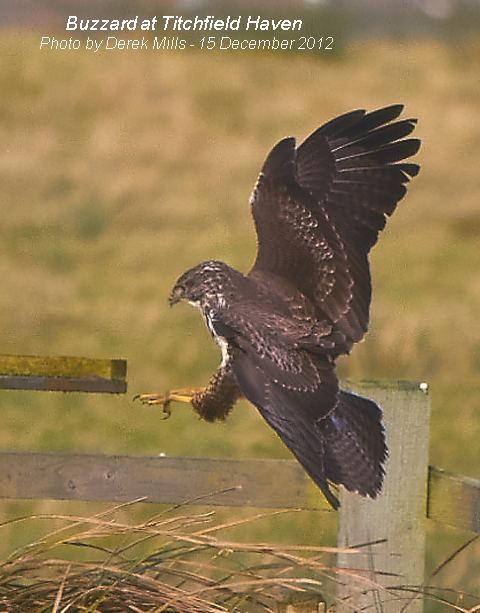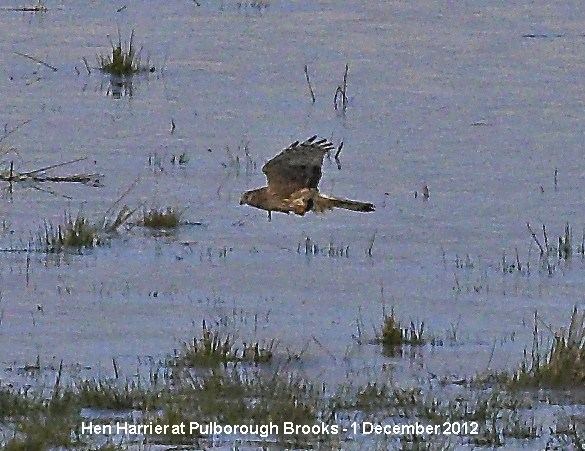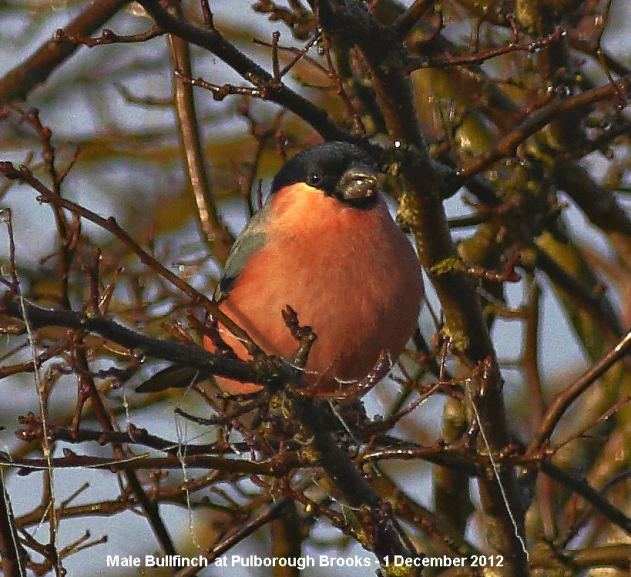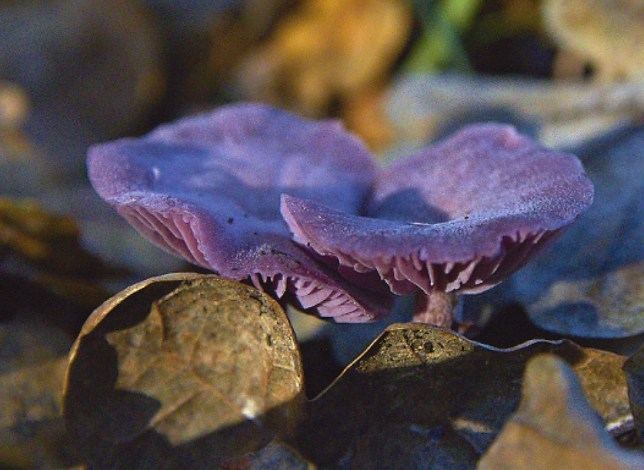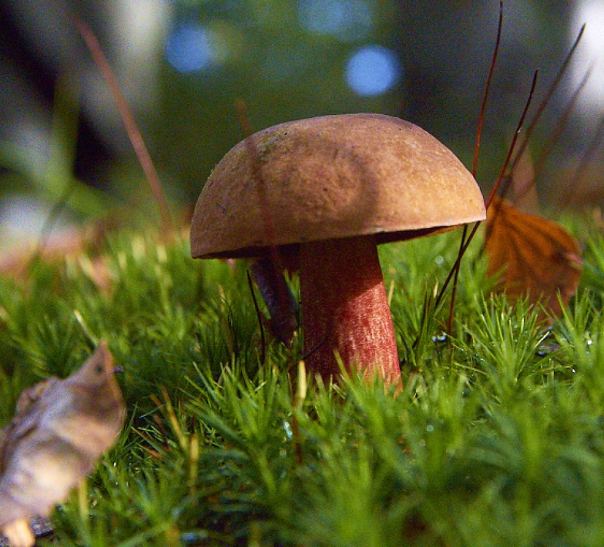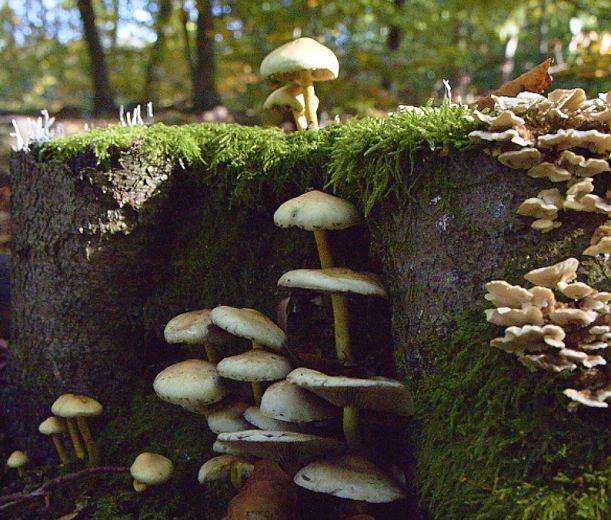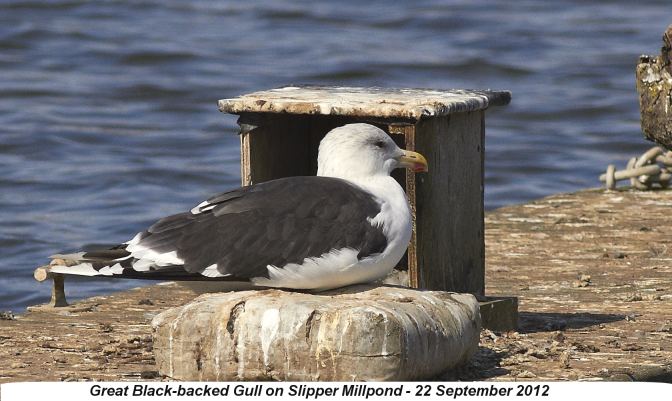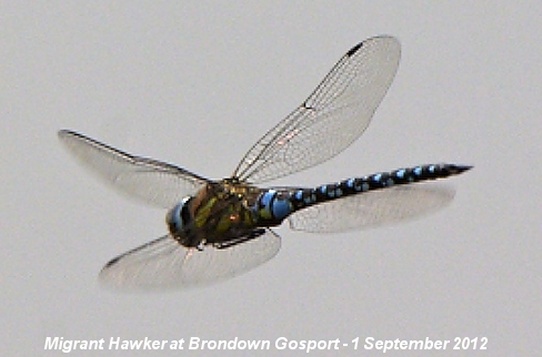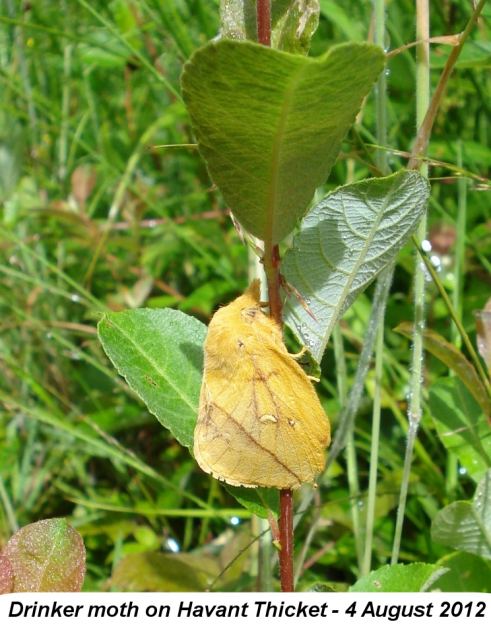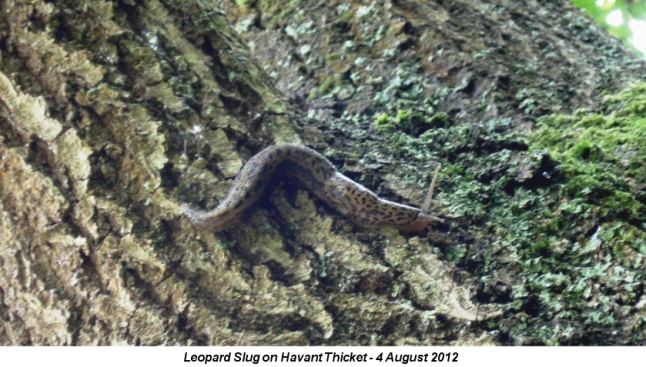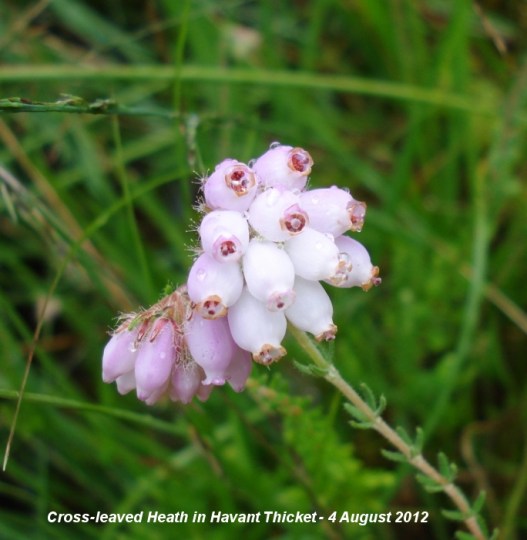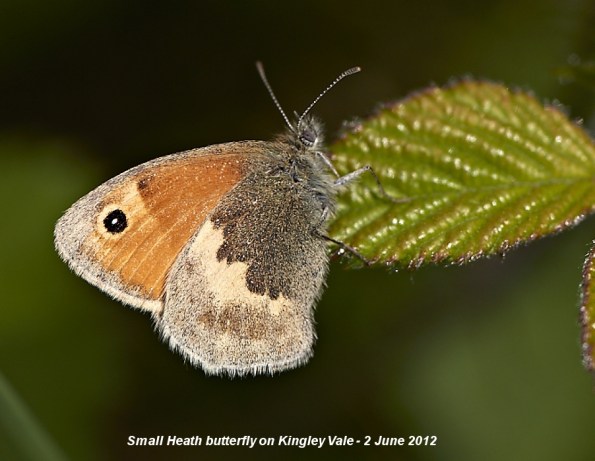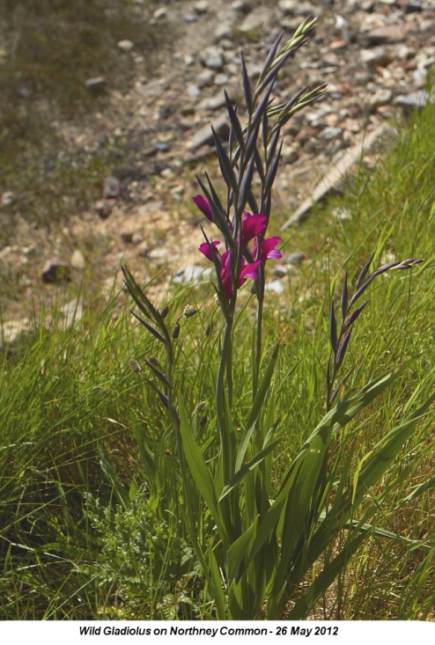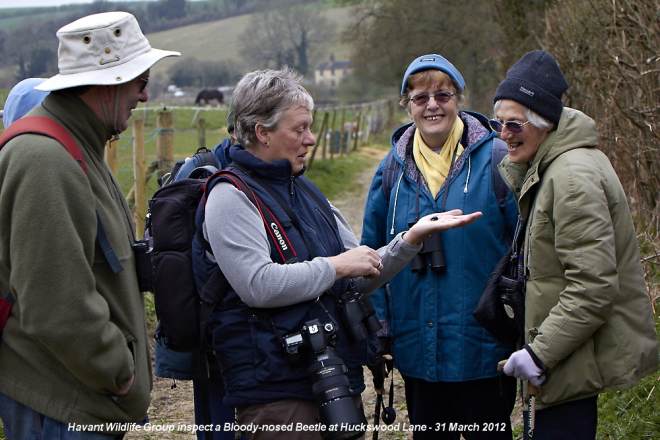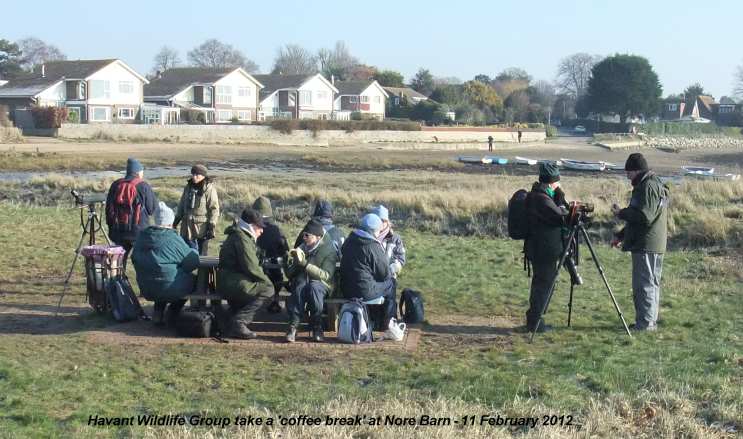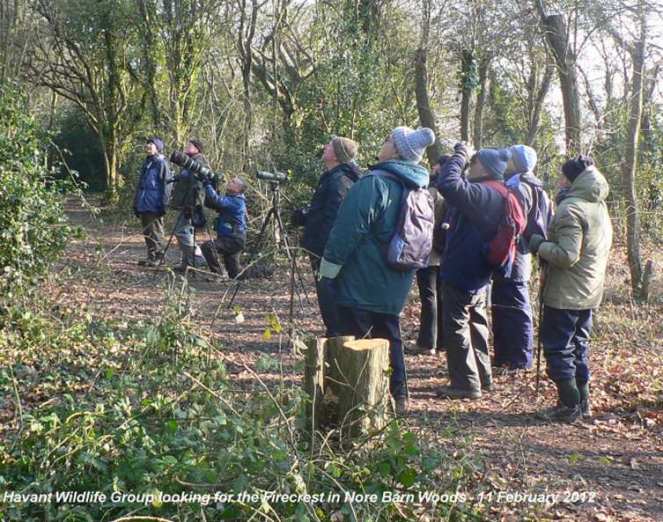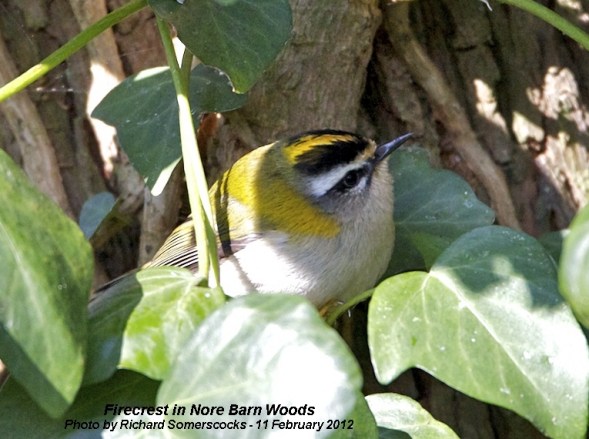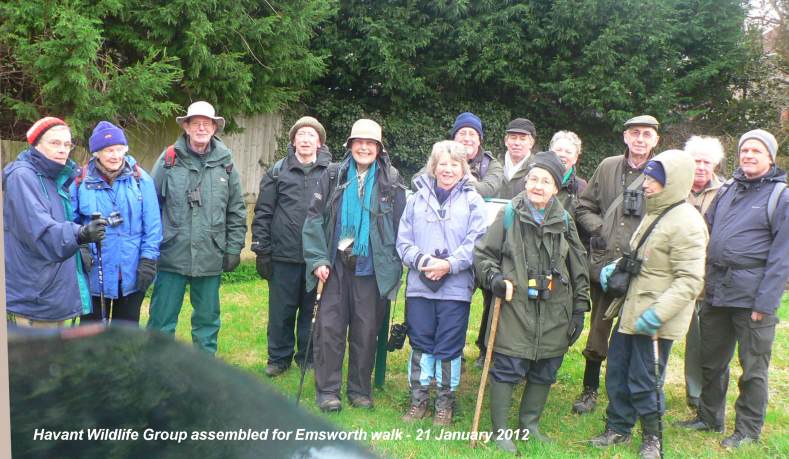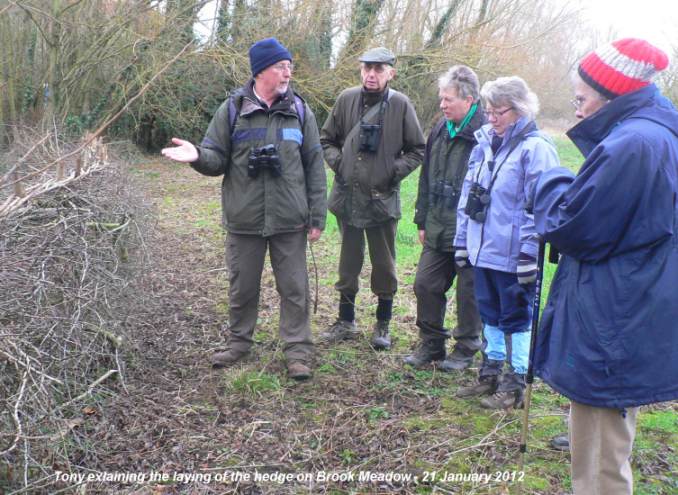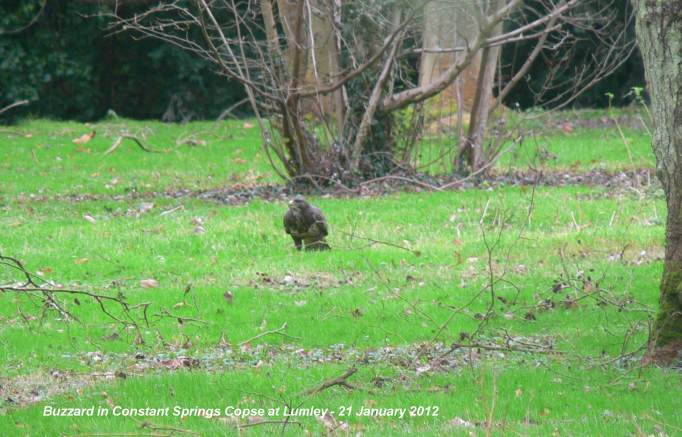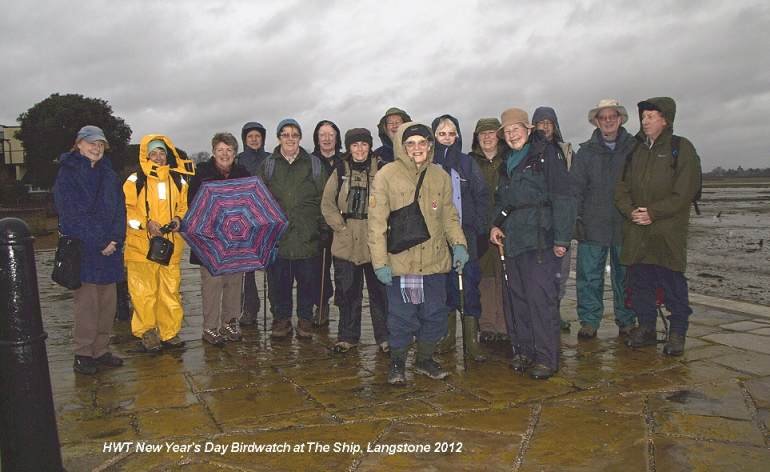HAVANT WILDLIFE STUDY GROUPREPORTS OF SATURDAY WALKS 2012
. . . .
SATURDAY December 15 - 2012 - Titchfield Haven
SATURDAY December 9 - 2012 - WALDERTONChris Cope reproted on yesterday's walk by the Havant Wildlife Group at Walderton.
"Eight of us met at Walderton on a gloriously sunny morning. In Woodlands Lane, we saw Nuthatch, Marsh, Coal, Great & Blue Tits on bird feeders outside a house, & Longtails, Chaffinches & Goldfinches. In Watergate Hanger, we had good views of Firecrest & Goldcrest, & saw Nuthatch, Treecreeper & a Jay. There were large clumps Mistletoe high up in the trees on the edge of Woodbarn, past "Watergate" we saw Jackdaw, & a Mistle Thrush in the fields
At coffee break on top of the hill, we saw 10 Pied Wagtails & 15 Skylarks. Coming back across the fields we saw a Bullfinch, Yellowhammer, Sparrowhawk & Buzzard & more Firecrests, Goldcrests & a Wren alongside the Ems. We found Dandelion, Daisy,White Dead-nettle, Bucher's Broom & Speedwell flowering along the way
A day to remember when it gets really cold. Thanks to Caroline for help with the bird list"
SATURDAY December 1 - 2012 - PULBOROUGH BROOKSHeather Mills reported on this morning's walk by the Havant Wildlife Group to the RSPB reserve at Pulborough Brooks.
"A really misty & cold morning for the trip to Pulborough. The highlights were my first Redwing, with a small flock of about 8 later. A female Hen Harrier flew low over the meadows looking towards Pulborough.
A Bar-headed goose was amongst the Canada geese along with a Greylag. The Bar-head apparently feral. A Bewick's swan was another first this year. 6 members enjoyed the close views of a male Bullfinch eating berries. 53 birds seen approx. We headed back for a well needed lunch, when the weather turned.
For a rather different Bullfinch have a look at this video on You Tube . . . http://youtu.be/SglQN14cJog
SATURDAY November 10 - 2012 - WEST WITTERINGChris Cope reported on yesterday's walk by the Havant Wildlife Group
Twelve of us assembled in drizzle in the car park at West Wittering this morning, luckily it soon cleared to leave a dull but mild day. We started by looking out to sea & got very excited by a Seal like object, but decided someone was being bit over imaginative. We tried to walk round the shore to Snow Hill, but having nearly lost one of the group in the mud, retreated to the upper path.
New sea defence works have cleared all the scrub which gives a clearer view of the ponds, where we saw Lapwing, Snipe, Redshank, Cormorant & Egret, but few small birds. There is just hard landscaping there at present, hopefully some of the £1.8 million they are spending will be spent on some bushes.
On the sea side of the wall, we watched a Curlew at close quarters, eating a crab, it kept dropping it till all the legs fell off, to make it easier to swallow, it then ate the legs, there were Redshank, Spotted Redshank, Bar & Black-tailed Godwits & Brent Geese here.
Near to Ella Nore we saw a Rock Pipit & Turnstone in the seaweed on the strand line, but the highlight of the day was a good view of four Common Scoter. Heather says they were probably female & that her Birds of Hampshire book says they are usually seen on spring passage in & around Hayling Bay. Dunlin, Great Crested Grebe, Shelduck, Red-Breasted Merganser, Ring Plover & Goldcrest were also seen.
SATURDAY November 3 - 2012 - NUTBOURNE TO PRINSTEDCaroline French reported on this morning's walk by the Havant Wildlife Group.
"Thirteen of us set out this morning for a walk from Nutbourne to Prinsted. We started at 9 a.m. and, with high water at 13.20, we decided to go along the sea wall first so that we would have the best chance of seeing waders and wildfowl. There was a strong and chilly south-westerly wind blowing in off the sea.
The bay at the top of Nutbourne Channel had plenty of birds, including the regular colour-ringed Greenshank GY+GY. There were about 30 Lapwing on the tilled field north of the bay and we witnessed the flight of about 100 Black-tailed Godwits flying west. Best of all were the c.20 Avocets which flew south-west out of the bay area, landing on a distant mudbank. These are the first I have seen this winter. The biggest surprise was a single Swallow! We had our coffee break on the benches at Prinsted and took the footpath through the fields back to Nutbourne. Tony Wooton and I decided to have a final look at the bay again before heading home, hoping to see the Avocets roosting. We were out of luck but were rewarded with a sighting of four Ringed Plovers on the shingle spit. We had failed to spot any at the top of the Prinsted Channel.
Full list of bird species seen:
Lapwing, Black-tailed Godwit, Dark-bellied Brent, Oystercatcher, Dunlin, Wigeon, Redshank, Greenshank, Starling, Kestrel (2+), Great Crested Grebe, Avocet (c. 20), Jackdaw, Rook, Grey Plover, Meadow Pipit, Turnstone, Curlew, Black-headed Gull, Herring Gull, Red-breasted Merganser. Woodpigeon, Song Thrush, Long-tailed Tit, Blackbird, Robin, Pintail (4), Goldfinch, Pied Wagtail, Buzzard (2), Cormorant, Little Egret, Stock Dove, Swallow (1), Blue Tit, Magpie, Feral Pigeon, Great Tit, Collared Dove, House Sparrow, Skylark (7+), Dunnock, Greenfinch, Pheasant, Green Woodpecker, Chaffinch, Ringed Plover.
We also had four separate sightings of Red Admirals battling bravely against the wind.
NB Walk around Farlington Marshes on Saturday 24th November.
Please note that we currently don't have a walk leader for this date so it will be a case of turning up at the usual time at 9 a.m. and going around with whoever is there on the day. Due to works being carried out on the sea wall it will not be possible to do the usual circular walk or to access The Lake. However, it will still be possible to walk down to the Deeps and Point Field.
SATURDAY OCTOBER 6 - 2012 - HAVANT THICKETHeather Mills reports on this morning's walk by the Havant Wildlife Group in Havant Thicket
12 enthusiasts met on a chilly but fine morning at Havant Thicket. Beryl also arrived but only to say cheerio, as she was off to South Africa to holiday. Unfortunately Rosie was not around to give us her expertise in fungi I.D. but Jim pointed us in the right direction with the aid of a few books which we had brought along. Not many birds but some did get a glimpse of & hear a male Bullfinch, with a couple of others. Coal tit, along with blue and long tails.
Good morning for fungi as we expected. The most prolific fungi being the Amethyst deceivers. Fly agaric, candle snuff, yellow stag's horn, common earthball, sulphur tuft, a toughshank of some kind and a good few others not identified. The beech wood to the right of the footpath on our return journey had the most diverse fungi, which Derek captured some for your perusal. Nothing out of the ordinary I suspect. Tormentil, clover, Stitchwort, cutleaf Cranesbill & gorse, with cross leaved heath. in flower.
Here are just three of the fungus photos sent by Heather. Any offers for IDs?
SATURDAY OCTOBER 6 - 2012 - Hook with WarsashChris Cope reports on today's walk by the Havant Wildlife Group.
Nine of us met in the car park in Hook Park Road where we saw Song & Mistle Thrush. Two Jays, a Green Woodpecker & Swallows flew over head. We heard a Cettis Warbler on the path to the sea & saw Blue,Great & Long-tail Tits in the Tamarix. Out on the shore there were a good many Oystercatchers & one Brent on a shingle spit. Lapwing & Curlew in the fields.
In the ponds there were Wigeon, Teal, Pochard, Black-tailed Godwits, one still in summer plumage, Canada Geese with one Greylag, Shoveler, Little Grebe, LittleEgret, Shelduck, Gadwall & one snipe. A Sparrowhawk put up a flock of Yellow Wagtail. A Stonechat & a Whinchat on the fence posts were useful for comparison & there were Pied Wagtail & Pipits in the grass.
We sat in the sun on the beach for coffee break & watched a Great Crested Grebe fishing.
During the morning we saw quite a few Swallows flying up the river, why are they flying north? Caroline saw a House Martin when we walked inland. Walking back along Workmans Lane, Heather first spotted a Green Woodpecker on a fence post, then two female Redstarts, they were catching insects on the field then flying back to the posts, so we were able to watch them for a long time, thanks to Heather we all had one of the best views of, for some of us a rarely seen bird, to round the day off a Heron flew overhead & we saw a flock of Long-tail Tits in a dead tree.
They also saw a lot of a Red Admirals, a Comma and a Small White nectaring on the Ivy
SATURDAY September 22, 2012 - Emsworth to ThorneyHeather Mills reported on this morning's walk b y the Havant Wildlife Group
On behalf of Fay who led this mornings walk from Bridge Road, here is a quick account. On a glorious but slightly chilly morning, 16 attended and were met by Brian, who gave his greetings and apologised for not joining us. We had a very pleasant amble around Emsworth, first noting the wonderful display of Mistletoe on the local apple tree.
Tide out as we looked for waders. Curlew, Oystercatchers and Black tailed Godwits seen with 3 Pied wags on the foreshore. As we went around the millpond, which incidentally was being drained in preparation for tomorrow's onslaught of rain, we saw a few more waders but nothing like Brian's mention of over 100+ Black-tailed Godwits. As we looked about, a male swan frightened the group by flying right towards us and then more or less gave up and landed at our feet against the sea wall. It unfortunately looked a little worse for wear as it limped off.
As we approached the end of the pond more Black-tailed Godwits could be seen but no rings visible. Approximate 30+. A Sandwich tern could be seen preening. Single Greenshank seen and Redshank amongst Turnstones and the usual Blackheaded gulls. Further out towards Thorney, Grey plover were some of the 39+ species seen.
We continued our walk and had a break in front of the stilt houses and finished by searching for Bearded Tits, to no avail. Plants mostly bristly Ox tongue,& Mallow.
On Slipper Millpond we noted the sorry demise of the Strawberry tree. Many Red Admirals seen and a few large whites. An Great Black-backed Gull looked out at us from the raft on the mill pond but looked like a mature bird. Was this one that bred and was back to stake an early claim to this spot? Huge mullet seen in the marina moat.
Notes on the Great Black-backed Gull
from Brian
Yes, this is an adult Great Black-backed Gull, probably one of the pair that nested on Slipper Millpond. The family with the two youngsters are still in the Emsworth Harbour area and are fairly regular visitors to Slipper Millpond. It must feel like home!
from Ralph Hollins
Seeing Heather's photo of the Adult Great Black-backed Gull back on the Slipper Mill Raft, and noting the dark streaks it has acquired on its head as it moves into winter plumage, I went to see if I could find a recent photo of an adult on Brian's web pages but failed to do so.
What I did find was a webpage with a slide set of six pictures showing the plumages from juvenile to adult which you might find useful in following the development of the Emsworth GBB dynasty and from this website I learnt something that I did not previously know - that the
Great Black-back is the largest gull in the world (checking this I found that the maximum body length of a GBB is 6 cm longer than that of a Glaucous Gull and the GBB maximum wingspan is 8 cm longer than a Glaucous). The website concerned is . . . http://www.allaboutbirds.org/guide/great_black-backed_gull/id
SATURDAY AUGUST 18 2012 - BrowndownRos Norton reports on this morning's walk by the Havant Wildlife Group:
There were 7 on todays walk at Browndown ranges SSSI. We started from Elmore car park, Lee on Solent and walked along the shingle and coastal heathland on a cloudy morning.
Highlights among the plants were large areas of ling and bell heather visited by bees. Dodder, parasitic on gorse was in flower. There was a patch of pale toadflax, rock samphire, yellow horned poppies, musk and tree mallow, burnet roses, and bittersweet. Thrift, sea campion and vipers bugloss were almost over and nottingham catchfly was in seed. A really tiny plant may be rock sea-spurrey.
Insects included white and meadow brown butterflies, a silver y moth and a migrant hawker dragonfly.
Birds included 2 wheatear, greenfinch , whitethroat, cormorant, tern and a flock of oystercatchers.
SATURDAY AUGUST 18 2012 - Old Winchester Hill.Jean Hildersley reported:
A robin greeted 11 of us in the car park . Other birds seen were song thrush, swallows heading South, gold finches, male yellow hammer, linnets, white throat, chiff chaff, spotted fly catcher, we looked down on 2 buzzards circling in the valley, kestrel hovering. Willow warbler and jackdaw heard
An abundance of flowers included rest harrow, red bartsia, rosebay willow herb, wild parsnip, field and small scabious, hoary and common ragwort, agrimony, marsh, nodding, carline, musk and creeping thistle, harebell, eye bright, yellow-wort, fairy flax, round headed rampion, field gentian, scarlet pimpernel, corn marigold, common poppy, corn flower, marjoram, black knapweed, white knapweed and wild bazil.
Butter flies - several brimstones, meadow browns, peacock, small skipper, gate keeper, tortoiseshell, red admiral , holly blue, chalkhill blue, common blue, speckled wood.
Soldier beetle, 2 roe deer, 6 spot burnet moth, caterpillar of cinnabar moth, 22 spot ladybird , possible harlequin lady bird.
SATURDAY AUGUST 11 - 2012 - BURTON MILLTony Wootton reported on the Havant Wildlife Group walk .
"6 of us had a lovely morning at Burton Mill, which probably didn't produce the variety or quantity of butterflies and dragon/damsel flies that we might have expected on such a hot and sunny day. It did provide a cracking finish though with 2 hobbies and a red kite all together in one line of vision. We also saw the following,
Birds
great crested grebe, blue tit, woodpigeon, moorhen, juvenile buzzard, great tit, nuthatch, goldcrest, great spotted woodpecker, chiffchaff, wren, green woodpecker, coal tit, cormorant, carrion crow, goldfinch, linnet, blackbird, jackdaw, stock dove, grey heron, mallard, mute swan, little grebe, coot, jay, tufted duck, kingfisher, reed warbler, swallow,Flowers
hemp agrimony, convolvus, purple loosetrife, greater celandine, rosebay willowherb, self heal, wood sage, marsh thistle, figwort,heath speedwell,enchanters nightshade, ling, teasel, alder, scots pine, red campion, herb robert, burdock, white bryony, common hemp nettle, greater birdsfoot trefoil, meadow vetchling, box, ribwort plaintain, black knapweed, hedge woundwort, hogweed, western red cedar, coastal redwood, western hemlock, douglas fir, common cow wheat, yellow loosestrife, gypsywort, skull cap, water plantain, agrimony, watermint, branch burrweed, common fleabane, bristly oxtongue, white deadnettle,common mallow, bittersweet, bell heath,Butterflies
meadow brown, gatekeeper, beautiful demoiselle, speckled wood,peacock, ruddy darter, large white, comma, common blue, brown hawker, common blue damselfly, azure damselfly, skimmer,small heath, speckled wood, silverwashed fritillary.A great many thanks to Caroline for doing all the hard work of recording and apologies if I've missed anything.
SATURDAY AUGUST 4 - 2012 - HAVANT THICKETCaroline French reports on the walk by the Havant Wildlife Group:
"Seven of us met this morning for a walk around Havant Thicket. We were not hopeful of seeing many butterflies or reptiles due to the mainly cloudy skies. However, butterfly species seen were Gatekeeper, Meadow Brown, Silver-washed Fritillary (1), White Admiral (1), Speckled Wood, Ringlet and several Small Skippers.
Tony spotted a lovely large moth settled in the low vegetation which turned out to be a Drinker (Philudoria potatoria). It gets its name from the larval habit of drinking water droplets from leaves.
Derek spotted a Leopard Slug (Limax maximus) two metres up a tree
Heather found an Adder basking next to the path, not far from where I saw one yesterday. Once again, it was camera-shy! A Common Frog(let) was also seen.
A good number of plants in flower were identified, including Common Fleabane, Great Willowherb, Wild Angelica, Marsh Thistle, Red Clover, Red Bartsia, Tare, Creeping Thistle, Common Ragwort, Hoary Ragwort, Hedge Woundwort, St John's Wort, Black Knapweed, Dandelion, Black Medick, Foxglove, Hemp Agrimony, Eyebright, White Clover, Wild Parsnip, Self-heal, Germander Speedwell, Buddlea, Meadowsweet, Common Birdsfoot-trefoil, Honeysuckle, Wood Sage, Cut-leaved Cranesbill and Cross-leaved Heath, which I mistakenly reported as Bell Heather yesterday.
Few birds were seen but we did come across a large mixed flock of small birds which included Long-tailed Tits. We saw one Yellowhammer and heard Goldcrest song. Coal Tit was seen and Nuthatch, Chiffchaff, Green Woodpecker and Common Buzzard heard.
Other sightings were Crab Spider, Harvestman and Cinnabar Moth caterpillar. We also had a good sighting of a large dragonfly which I think may be an immature Southern Hawker
SATURDAY JULY 14 - 2012 - STENHAM & IPING COMMONChris Cope reported on the Havant Wildlife Group walk:
Six of us, including Helen & the girls, which was a nice surprise, walked over Stenham & Iping Common, it was very wet under-foot, but didn't start to rain until the last half hour. Crossing Stedham Common we saw Heather, Cross-leaved Heather, Tormentil, Lesser Stitchwort & Wood Sage.
Along the road leading to Minsted Farm, Heather spotted a Nuthatch & Pied Flycatcher feeding their young & Chaffinch, Great tit, Blue tit & Coal tit .
We found Dark Mullein, Hedge Woundwort, Green Alkanet & Greater Celandine, which when you cut it's stem it oozes a yellow latex, this is because the plant belongs, strangely, to the Poppy family, & is supposed to cure warts.
We heard a Green Woodpecker & saw Song Thrush on the fields, & saw Chicken-in the Wood.
The Mosses in the Sandstone cutting were thriving well, with all this rain, parts of the path were running with water.
Walking back along the private road to Fitzhall there was a field of grasses with pink stems which made a very pretty sight, but I am afraid we were unable to identify it.
By the Lodge house was Musk Mallow, Fox & Cubs, & English Stonecrop all along the road side & then it started to rain, again.
Back on Stedham Common, we found Harebell & saw a Small Blue butterfly, possible Silver-studded, there were hardly any butterflies but we saw Red Admiral, Ringlet & Meadow Brown.
Back in the car park Swift & House Martin flew overhead, Heather & Derek saw a Bullfinch & Yellowhammer before they left
SATURDAY JULY 8 - 2012 - THURSLEY COMMONHeather Mills reports on the Havant Wildlife Group walk
5 met on a decidedly cloudy day with most of the rain having already fallen as we arrived. We set off full of trepidation at the sodden ground and large puddles everywhere. However, we were quickly rewarded with a merlin chasing a swallow flock from above . This was quickly followed by 2 hobbies on the wing and a large group of swifts.
After our enjoyment at seeing these aerial acrobatics we concentrated on the flora. Bog asphodel, marsh orchids, bell Heather, ling and cross leaved heath with some creeping thistle type all gave a wonderful mix of colour. We had a very large caterpillar possibly a drinker, and after it warmed up a smattering of common lizards.
Sky lark , reed bunting and whitethroat could be heard singing and stonechats could also be heard making their calls. We found the raft spider on our way over the boardwalks and at coffee break had the delight of a woodlark singing in flight. A couple of young great spots appeared together with a green woodpecker.
One butterfly seen all day and not sure if common blue or silver studded as it did not open. As we returned via planks to stop us sinking into the bog we had to backtrack and ended up in the fir tree plantation at the edge of the lake. This gave great views of a mixed flock of tits, coal, long and blue. Treecreeper, nuthatch and goldcrest. 26 species seen or heard. Derek & I returned after lunch and got the marsh St Johnswort in flower together with a possible marsh lousewort. Also a flock of young chiffchaffs with another mixed flock.
SATURDAY JUNE 29- 2012 - NOAR HILLReport by Chris Cope: Nine of us had a very enjoyable walk on Noar Hill today which was brimming with flowers. We saw two Yellowhammers, the first in it's usual spot where we park the cars. We also saw Linnet, Whitethroat, Goldfinch, a Kestrel, Green Woodpecker, Chiffchaff, & heard a Skylark, Blackcap & Great Spotted Woodpecker.
We found Hound's-tongue, Pyramindal, Fragrant, Musk & Common Spotted Orchids & Common Twayblade. We met a man who had found three Frog Orchids, but we didn't find them inspite of my trying to morph three Twayblades into them. There were great swaths of Rock-rose & Kidney Vetch, but none of their associated butterflies
Among the many flowers seen were - Agrimony, Eyebright, Thyme, Quaking grass, Small Scabious, Musk Thistle, Black Medick, Salad Burnet, Meadow Vetchling, Kidney Vetch, Great Mullein, Milkwort, Perforate St John's-wort, Yellow-wort, Field Woundwort, Selfheal, Spurge, even a few Yellow Rattle still in flower, Sanicle in the wooded area & White Bryony in the hedgerow. We studied Field, Dog Rose & Sweet Briar, to learn to distinguish between them, but failed to find the Dragon's-teeth.
It was too windy to see many butterflies, but we saw a Small Blue, Meadow Brown, Small Heath & a Red Admiral
SATURDAY JUNE 16- 2012 - PORTSDOWN HILLCaroline French reported on this morng's walk by the Havant Wildlife Group.
"A small but enthusiastic party of four had an enjoyable walk around the north side of Portsdown today, starting just west of the Churchillian pub. We walked a square route, north from the carpark to the bottom of the first field, then followed the path west, crossing over Widley Walk then through a small copse before turning south and up the hill towards Fort Widley, then east back to the car park. It was extremely windy so not the best conditions for looking for birds or insects but we did manage to identify 80 plant species (not counting most of the trees). Full list of observations as follows:
Plants: Yellow Rattle, Red Campion, Creeping Buttercup, Lesser Stitchwort, Hogweed, Meadow Buttercup, Birdsfoot Trefoil, Tuffted vetch, Mugwort, Cut-leaved Cranesbill, Common Field Speedwell, Germander Speedwell, Kidney Vetch, Red Deadnettle, Dog Rose, Black Medick, Garlic Mustard, Hedge Mustard, Goosegrass (Cleavers), Spindle, Field Bindweed, Red Clover, White Clover, Wayfaring Tree, Dogwood, Spear Thistle, Marsh Thistle, Smooth Sowthistle, Rough Sowthistle, Goatsbeard, Beaked Hawksbeard, Rough Hawksbeard, Cow Parsley, Wild Carrot, Ground Ivy, Greater Plantain, Ribwort Plantain, Wintercress, Broomrape, Fumitory, Rough Chervil, St John'sWort, Daisy, Oxeye Daisy, Wild Mignonette, Bladder Campion, Yarrow, Scarlet Pimpernel, Dock, Common Sorrel, Common Groundsel, Stinging Nettle, Hedge Woundwort, Elder, Common Toadflax, Crosswort, Traveller's Joy, Herb Robert, Wood Avens, White Deadnettle, Ribbed Melilot, Greater Knapweed, Black (Common) Knapweed, Cowslip, Common Spotted Orchid, Poppy sp., Marjoram, Hemp Agrimony, Milkwort, Fairy Flax, Salad Burnet, Bramble, Viper's Bugloss, Lucerne, Common Mouse-ear, Cocksfoot, YorkshireFog, Perennial Ryegrass, Wall Barley, Quaking Grass,
Insects: Red Admiral, Holly Blue, Thigh Beetle, Seven-spot Ladybird (I initially thought it had 6 spots but I think I forgot to include the large spot behind the head)
Birds: Swift, Swallow, Starling, Whitethroat, Buzzard, Yellowhammer (heard only), Wren, Greenfinch, Goldfinch, Long-tailed Tit, Magpie, Woodpigeon, Jackdaw, Rook, Carrion Crow, Black-headed Gull.
Mammals: Badger set.
SATURDAY JUNE 8 - 2012 - PORTSDOWN HILLRos Norton reported on this morning's walk by the Havant Wildlife Group.
There were 8 of us on today's walk . The weather was sunny but breezy. We walked from the car park east of the A3 around a field south of the road and then past Fort Southwick. We saw very few insects but Speckled Wood, Holly Blue and Small White butterflies were seen. Birds heard included Greenfinches and Whitethroat and those seen included Jackdaws, a Stock Dove and Kestrel around the fort.
Flowers included hundreds of Pyramidal Orchids, rather less Common Spotted Orchids and a few Bee Orchids. Many other flowers included Common Gromwell, Columnbine, Red Valerian, Rock Rose, Kidney Vetch, Field Madder, Ox-Eye Daisies, Mouse-Ear Hawkweed, Rest Harrow, Yellow Wort, Meadow Vetchling, Wild Mignonette, Weld, Viper's Bugloss, Bladder Campion and Milkwort.
SATURDAY June 2 2012 - Kingley ValeChris Cope reported on the Havant Wildlife Group on Kingley Vale .
"Eleven of us walked round the lower slopes of Kingley Vale, we saw a Raven, Buzzard, Skylark, Yellow Hammer, female Blackcap & Swallow, & heard a Chiffchaff, Bullfinch, Great Spotted Woodpecker & Firecrest.
On the path leading up to the reserve we saw Spindle in flower, Spurge Laurel with it's black berries & Goat's-beard. On returning we saw four Roe Deer.
We found Three-veined Sandwort at the side of the path in the wood.
Most of the flowers were on the hill on the west side of the reserve & included Fairy Flax, Bastard Toadflax, Common Gromwell, Field Madder, Common Spotted Orchid, Kidney & Horseshoe Vetch, Common Rock-rose, Salad Burnet & two more Roe Deer.
There were not many butterflies about, but we saw Speckled Wood, Green-veined White, Red Admiral, Brimstone, Small Heath, Holly & Small blue,possibly a Dingy Skipper & a Cinnabar moth."
SATURDAY May 26 2012 - North Common Hayling.Chris Cope reported on yesterday's walk on North Common Hayling.
Nine of us enjoyed a warm but very windy walk on North Common Hayling. There were few birds, but we saw Whitethroat, Greenfinch, Linnet, Little & Common Tern, Egret, a Green Woodpecker & heard a Stock Dove.
The Hedgerow Crane's-bill is still there by the entrance, the whole area is awash with Black Medick & the Grass Vetchling particularly abundant. Two more unusual sightings, were two Cowslips near the entrance to the Marina & a Wild Gladiolus - or possibly Eastern Gladiolus. See Heather's photo.
Although it was very windy, we saw quite a few butterflies, including a Small Heath, Holly Blue, Painted Lady, Small & Green-veined White, several female Orange-tips, Speckled Wood & a Red Admiral.
SATURDAY May 19 - 2012 - HAYLING ISLANDChris Cope reported on yesterday's walk by the Havant Wildlife Group around the south west corner of Hayling Island.
Seven of us met at the Gunsite Hayling & were greeted with the sound of a Cuckoo.
Walking through the gorse we saw a Small Copper & Orange-tip butterflies, there were large areas of Sheep's Sorrel, turning the ground red, a very large Great Mullein ( not in flower) & some Heath Groundsel.
The Kench provided us with it's usual problems with it's white Crucifers, with English Scurvygrass, Common & Hoary Whitlowgrass proving a challange.
Along the western coast, Spring Beauty was very abundant under the Tamarisk, Sea-kale on the shingle & a Whitethroat in the bushes. The Sea Sandwort is just coming into flower.
On the common there were plenty Green-winged Orchids, Thrift, Birds-foot-trefoil, Sea Campion, & a few Yellow Rattle, plus a Meadow Pipit on the golf link's fence.
Returning alongside Links Lane we heard two Blackcaps & saw a Birmstone butterfly & Bur Chervil.
SATURDAY APRIL 28 - 2012 - LOWTON'S COPSEJean Hildersley reported on this morning's walk by the Havant Wildlife Group in Lowton's Copse.
Despite persistent rain, 8 of us had a very interesting walk around Lowton's Copse. The main draw for this venue are the bluebells which were many and still in flower but going over. There was much excitement before the risk assessment could be read as Firecrests were heard and seen
Birds: Firecrest, Song Thrush, Blackcap, Marsh Tit, Coal Tit, Great Tit, Chiffchaff, Buzzard, Robin, Hawk?
Flowers: Bluebell, Wood Anemone, Wood Spurge, Yellow Archangel, Selfheal, Early Dog-violet, Ramsons, Primrose, Garlic Mustard, Greater Stitchwort, Wild Strawberry, Goldilocks buttercup, Wayside Reserve, Common Vetch, Early Purple Orchid, Twayblade orchid, Wood Anemone, Solomons Seal, Ivy-leaved Speedwell, Wood Speedwell, Lords and Ladies, Toothwort, Not in flower but very close - red campion & marsh thistle & figwort & a St johnswort.
Hope to see you on the 12th. May at Portchester.
SATURDAY APRIL 21 - 2012 - HOOK WITH WARSASHChris Cope reported on this morning's walk by the Havant Wildlife Group.
"Three of us had a very pleasant walk along the shore at Hook with Warsash. We heard Song Thrush, Chaffinch, Black Cap, Cettis Warbler, Chiffchaff and Skylark, but no Nightingales.
We watched a Little Egret have a difficult time trying to swallow what looked like a small fish, it must have picked it up and dropped it up to 10 times and on eventually swallowing it kept stretching its neck.
On joining the beach from the footpath we found large clumps of Alexanders and wondered if they were edible - according to Flora Britannica it was introduced by the Romans and every part, from root to flower tip was used as an all purpose spring vegetable & tonic and it favours growing near the coast.
We found a lot of Spring Beauty growing on the edge of the common, this is another foreigner, from North America, and can either be used as a salad or a cooked vegetable. (Flora Britannica)
Further culinary delights were to be found on the beach in the form of Sea Kale, this again is edible, especially the young shoots where they have been naturally bleached while growing through the shingle. (Flora Britannica)
We also saw Sheep's Sorrel, Sea Campion, Lesser Stitchwort, & Honesty.
There were many clumps of Bluebells in the field behind the car park, but quite a few without any flowers, maybe because there were horses in the field, as the flowers where mainly in the less accessible places.
SATURDAY MARCH 31 - 2012 - Huckswood LaneHeather Mills reported on this morning's walk by the Havant Wildlife Group
7 met & enjoyed a much colder morning walk in a reverse fashion to our normal climb up Huckswood Lane. 31 species of bird seen with the constant calling of siskin in the air. We stopped to admire a "bloody nosed beetle".
The walk along Harris lane was of particular interest in all the felling and replanting on either side which has taken place. Nigel investigated the collars around the young trees and found most of them to be ash. Bluebells, wood anemone, lesser celandine, greater stitchwort, dog's mercury, ground ivy, wood sorrel, wood spurge & coltsfoot and Moschatel were all in flower. Too cold for butterflies.
We stopped at Harris Well and read the grisly story of a murder that had taken place in the 1700's, and Nigel noticed the hidden pond a bit further along which probably had been part of the grounds of this large estate. A large Norway maple was well in flower.
SATURDAY MARCH 24 - 2012 - STAUNTON PARKHeather Mills reports on the Havant Wildlife Group walk this morning:
Ten met on a very sunny and warm morning at Staunton Park and enjoyed the delights of this
unsung part of Havant. We followed the footpath around the lake and stopped to hear the first of many chiffchaff singing, together with nuthatch. Tree creeper were in abundance ( at least 6 seen ) around the park, with particular close views at the end of the walk when one appeared out of a crack in a pine, only to fly in front of the group and proceed to try and dislodge a spider's web for it's nest. 43+ species of birds seen.
Caroline spotted at least a male bullfinch and possible mate, but they had vanished before the group got a look. A pair of kestrels mating and sounds of green and great spotted woodpeckers carried throughout the woods. At Gypsy plain Caroline confirmed her hearing the calls of Med gulls, when a flock of about 8 were "worming" in the next field, together with common and black headed gulls.
Dogs mercury, lesser celandine and wood anemone seen with some early dog violets. A small speedwell intrigued us and we now think it was ivy leaved.
I had informed the staff of our visit and a member came out at the end to speak to us. He mentioned that the kingfisher is a constant visitor to the lake perhaps because of the dry ditches. Woodcock have done very well here and barn owls are regularly seen. The careful management takes account of the many bat species around, one of which roosts in holes that woodpeckers and squirrels also frequent. Mandarin ducks have now vacated the lake, but did stay last year.
As the group left the park we had lovely views of courting brimstones which together with speckled wood, small tortoiseshell, comma & peacock made a fitting finale of sightings at this delightful spot. Jean mentioned an orange tip had emerged and bee flies seen hovering at the small garden outlet, were also a first this year.
Here is Heather's amazing photo of the courting Brimstones.
SATURDAY MARCH 17 - 2012 - BLASHFORD LAKESReport on the Havant Wildlife Group walk at Blashford Lakes on Saturday 17 March by Jean Hildersley.
Six of us were glad we drove through the rain to find the lakes cloudy but rain free - a good day bird wise.
We were greeted with a lovely show of wild daffodils. From the car park we heard and saw a spotted woodpecker drumming, saw nuthatch on feeder, dunnock foraging. Later saw 3 robins posturing on the path and a wren. A tree creeper was heard.
From the Woodland Hide - wonderful views of siskins,lesser redpoll, chaffinch, blue tit and great tit
The rarest bird was a water pipit with its white eye stripe, dark legs and pinky buff breast along with meadow and rock pipits.
On the lake we saw ducks - tufted, golden eye, shell, shoveler, teal, pochard, gadwall Pair of swans preparing nest, little and great crested grebe, goosander, grey and pied wagtail. Numerous cormorants. Pair of redshank, pee-wits calling and flying overhead, reed bunting, heron preening, cetti's warbler heard and chiffchaff calling..Roe deer seen. Scarlet elf cup fungi seen.
Many thanks as always to Heather and Ros for sharing their 'scopes and knowledge .
Heather and Derek added info about 2 water rail seen as they retraced our steps looking for the Bittern.
SATURDAY MARCH 10 - 2012 - PAGHAM HARBOURTony Wootton reported on the Havant Wildlife Group walk this morning: Nine people attended. The weather was warm but still and cloudy, although it was brightening up as we finished. We walked from Sidlesham (now with a RSPB sign) to the salt house on the eastern side of the North Wall.
Bird list: Red kite, Kestrel, Buzzard, Pintail, Wigeon, Shelduck, Mallard, Teal, Brent, Blue tit, Great tit, Longtailed tit, Magpie, Rook, Crow, Jackdaw, Robin, Blackbird, Song thrush, Dunnock, Wren, Greenfinch, Chaffinch, Starling, Cettis (heard), Green woodpecker(heard), Redshank, Snipe, Curlew, Knot, Grey plover, Golden plover, Avocet, Oystercatcher, Dunlin, Little grebe, Heron, Mute swan, Blacktailed godwit, Bartailed godwit, Goldfinch, Lapwing, Goldcrest, Reed bunting, Blackheaded gull, Great black back gull, Common gull, Med. Gull, Meadow pipit. I think Caroline had a few more than my list.
Flowers: Coltsfoot. Sweet violets. Primrose, Others: Roe deer. rabbit, but no butterflies.
There was no sign of the paddyfield warbler that 50 twitchers were looking for on the North Wall.
SATURDAY MARCH 3 - 2012 - STANSTED FORESTCaroline French reported on this morning's walk by the Havant Wildlife Group. Eleven people turned out. Heavy rain at 9am meant that the start of the walk was delayed for half an hour, by which time four of the group decided against continuing, leaving seven of us to enjoy what turned out to be a fruitful morning with some unexpected and very welcome sunshine.
From the car park we followed the tarmac road that cuts through North Coopers Wood, towards Stansted House. In the section of woodland to the south of the road we could hear what sounded like a very large flock of Siskins but although the sound was not distant, it came from the other side of the woods and disappointingly we were unable to see any of the birds. We did see a few Siskins in ones and twos during the course of the walk but no great spectacle. However, a little further on in the woods and on the field to the east of The Avenue we were greeted by the wonderful sight of over 100 Redwings, interspersed with just a very few Fieldfares and Mistles Thrushes.
Further on, past Orange Grove and the cottage on Monarch's Way, we heard the beautiful song of the Woodlark, which we managed to locate on a telephone wire. We thought that this was possibly one of two birds which we had seen fly in moments early but had been unable to indentify in flight. Skylarks were also in flight and song and Heather managed to pick out the black-tipped ears of a Hare, otherwise hidden in the crop of broad beans. We were also treated to the sight and song of at least two Yellowhammers.
The other main highlight was a Red Kite spotted by Derek and flying over the Racton area. Toward the end of the walk we had much better views of what was probably the same bird flying within a hundred meters of so of us over Forest Hanger. At one point it made a dash for the ground but was chased off by some Carrion Crows. It may have been trying to steal their food. There were at least three Buzzards soaring fairly close by but they made no attempt to chase off the Red Kite.
During the course of the walk we made a detour up towards Forestside in the hope of seeing Crossbills but we had no luck.
The full list of birds seen is as follows: Blue Tit, Jay, Jackdaw, Blackbird, Chaffinch, Redwing, Mistle Thrush, Fieldfare, Dunnock, Starling, Song Thrust, Carrion Crow, Nuthatch, Buzzard, Great Spotted Woodpecker, Goldcrest, Coal Tit, Goldfinch, Long-tailed Tit, Siskin, Woodlark, Great Tit, Robin, Skylark, Pheasant, Yellowhammer, Bullfinch, Red Kite, Green Woodpecker, Greenfinch, Pied Wagtail, Kestrel and Wren.
We also came across a Common Frog and a Common Toad.
SATURDAY FEBRUARY 11 - 2012 - EmsworthThirteen members of the Havant Wildlife Group assembled at 9am in Bridge Road car park this morning for a walk to Nore Barn via the town millpond. We were pleased to welcome Des Barker to the group. I knew Des from our days at Portsmouth University when we were members of the table tennis club and where Des was an ace player! The overnight temperature was the lowest for the winter at around -5 degrees (so I am told), but with virtually no wind and a warm winter sun the conditions were very good.
We stopped for coffee break at the picnic table at Nore Barn at about 11:00.
While in the car park we saw several Redwing perched in the trees of gardens and flying overhead and two Mistle Thrushes were in the tall trees overlooking the car park. We admired the good growth of Mistletoe on the apple tree in the garden opposite the car park.Many thanks to Peter Milinets-Raby for pointing out that the top bird in Heather's photo is in fact a Fieldfare, the lower one (with eye stripe) is the Redwing, so we got more than we thought. Two for the price of one, in fact!
The town millpond was partly frozen and most of the Mallard were standing on the ice. We noted the sole Canada Goose which has been on the pond for a few weeks.
We found a Rock Pipit scuttling around at the southern end of the millpond seawall and at one point was actually on the ice; this bird has been regular in the area by the Emsworth Sailing Club this winter.
As expected, the large flock of around 1,000 Knot were on the mudflats in the Nore Barn area and they put on some flying displays for us. The Black-tailed Godwits were mostly gathered in the creek to the west of Nore Barn, in similar numbers to previously (130+). Other birds seen in this area were Pintail, Wigeon, Teal, Brent Geese, Dunlin, Ringed Plover, Grey Plover, Redshank, Curlew, Oystercatcher.
I suggested we go into the woods to look for the Firecrest that I saw yesterday.
There was no sign of the Firecrest where I saw it yesterday, but we did get good views of at least two Goldcrests one in a Holly bush and the other imitating a Treecreeper on the branches of an Oak tree. There were lots of Tits in the woods and a pair of super Song Thrushes. I heard my first Chaffinch song of the year, not a complete song, but only a partial one. The full song does take some time to develop.
The Spotted Redshank arrived in the stream with its characteristic piping call, at about 12 noon. But by then most of the group were making their way back to the car park.
Richard Somerscocks stayed on after the group walk had finished and watched the Godwits gather at the end of the creek as the tide came in. The colour rings were almost the same as yesterday which suggests that the flock is fairly static at the moment; G+BW, G+WR, O+GB, W+WN, ROL+RLR and also L+LL which seems to have returned from Farlington where Richard saw it last on 27 Jan.
A mixture of a few Dunlin and Knot were still around as it approached high tide. A couple were alongside each other which provided a good comparison between these two waders.
Richard returned via the woods and found the Firecrest at the same spot where we were earlier. Persistence clearly pays dividends!
SATURDAY FEBRUARY 4 - 2012 - Hayling Billy TrailChris Cope reported on this morning's walk by the Havant Wildlife Group along the Hayling Billy Line.
"Ten of us braved what was expected to be a very cold walk on the Hayling Billy Trail, but as there was not a drop of wind, it turned out to be very pleasant. A flock of Linnets, with some Greenfinch & a Sparrow were first seen in the trees behind the factory units. In the field to the west of the line, we found a flock of Wagtails & Golden Plover. There were small numbers of Brent out on the water, with Dunlin, Curlew & Shelduck out on the emerging mud banks. Back on the Trail we saw a Buzzard (well some of us!) lots of Robins, a Jay, Green Woodpecker, a Kestrel, & Song & Mistle Thrush. Returning back down the trail, the tide was further out & we got some close views of Dunlin, Grey Plover, Turnstone, Oystercatcher & Goldeneye, Mergansers in the distance. The highlight of the day, was a flock of about 50 Golden Plover in a field on the east side of the line at the end of the walk."
SATURDAY JANUARY 28 - 2012 - Farlington MarshesHeather Mills reported on this morning's walk at Farlington by the Havant Wildlife Group.
"14 met on a chilly morning with a lot of cloud to dull the day. Nigel introduced a new member who is keen to see our selection of birds, which did not disappoint as about 40 species seen. I had been to Farlington twice in the past week and have never seen so many Pintail on the first pool . Usually they are on the East side. Today as the tide was out, they were in the channel on the mud banks and there were probably near 50.
We all had good views of a group of 5 Bearded tits on the far side of the pool at the base of reeds as they searched for food. As we looked at a close Snipe a Water Rail appeared for everyone to see. It later came out closer in the reeds but did not stay out.
A couple of Stonechats were present in the field alongside the footpath allowing us close views of the female. We saw some ringed Godwits, which I think Caroline took note of. After a coffee break, the Bearded Tits ( poss 7 this time), came closer to the footpath. We returned to take a look at the lake by the hut and saw 2 Buzzards. No rarities but good light and sunshine to warm us up. Alexanders in flower along the cycle route back to the car park.
SATURDAY JANUARY 21 - 2012 - EMSWORTH - WESTBOURNEReport by Ros Norton
"14 met at Bridge Road for a circular walk from Emsworth to Westbourne via Brook Meadow and fields and returned via Lumley Mill Lane. We saw 2 Mistle Thrushes in a tree bearing Mistletoe . A Buzzard was seen in a field perched in a tree. A Grey Heron was in a field of cattle. Other birds seen included Goldfinch and Greenfinch. Lots of birdsong heard including Goldcrest. A bumblebee was flying. Fungi included Wood Blewit in Brook Meadow. Lesser Celandines were in flower in Bridge Road wayside andin Westbrook churchyard where a Primrose was also in bloom. Other flowers included Hogweed, Ivy-leaved Toadflax and Winter Heliotrope."
Brian's additional notes and photos
Here is the group assembled in Bridge Road car park at the start of the walk taken on a timer from the bonnet of a parked car.
Here is Tony Wootton on Brook Meadow explaining the technique of hedge laying. This hedge was laid under the supervision of Mike from the Brook Meadow Conservation Group. A very nice example.
Here is my photo of the Buzzard when it briefly came down to the ground in the Constant Springs copse (ie the plantation between the path to Lumley Mill and the A27 embankment).
The Bumblebee was probably Bombus terrestris or Buff-tailed Bumblebee, which Bryan Pinchen says is now becoming a regular wintering Bumblebee. See his blog at: http://shoutingatseahorses.wordpress.com/
SATURDAY 14 JANUARY 2012 - Cams HallHeather Mills reported on today's walk by the Havant Wildlife Group:
"On Saturday 14th January, 11 of us braved a cold and frosty start at Cams Hall area Fareham east) following the path by the edge of water. It turned into a glorious sunny and calm morning but very few birds in trees. The tide was very low to start then rising to high at 14.28. Highlights included a Kingfisher which obligingly perched for a while during our coffee break. A male Goldeneye swam in the channel, 2 Greenshanks were feeding and we saw Snipe. There were a lot of Wigeon and other birds seen included Little Grebes, Little Egrets,a few Godwits, (one colour ringed orange over red with maybe blue on the right leg), Redshanks , Oystercatchers, Cormorants, Curlew, a Buzzard, Mallards, Teal, and various gulls. Flowers included both male and female Hazel catkins fully out."
SATURDAY 7 JANUARY 2012 - CHICHESTER GRAVEL PITSHeather Mills reported on this morning's walk by the Havant Wildlife Group:
"Fay sent her apologies for missing the walk due to her incapacity at present and I am sure we all send our good wishes for a speedy recovery. 12 gathered on a cloudy day to see the masses of Coots gathered on the lakes, together with good views of Pochard, and Gadwall. One Cormorant with white thigh patch. We followed the usual paths and saw 36+ species of birds. Spring lambs had made an appearance in the adjoining fields. Several views of Kingfishers on the eastern lakes, with 2 chasing off across the lake as we took a coffee break. . One Redwing seen.
Winter heliotrope and emerging Lords & Ladies leaves showing. Great Spotted Woodpeckers hammering in the Silver birches, and plenty of activity between the Great and Blue Tits. No Sparrows seen today which is unusual for the area around the hawkers tips of empty vehicles and rubbish strewn around."
Note: A sighting of a controversial bird was removed following advice from a local warden.
SUNDAY 1 JANUARY 2012 - NEW YEAR'S DAY BIRDWATCH - Report by Heather MillsHeather Mills sent the following report on the traditional New Year's Day Birdwatch which started from The Ship Inn at Langstone.
"15 enjoyed a very dull and eventually even wetter New Year's Day walk. However, we did get reasonable views of a good variety of birds on our way to Warblington Church. The highlight was the Cattle Egret in the field with the cattle, to the West of the church. We wondered if it could have been the same bird that came a few years back in the same area! Caroline spotted a couple of Bar-tailed Godwits as we looked across the mud flats from the Ship. Ralph Hollins met us at Wade Court and spoke of the blossoms that were currently out. Soon after Ralph left us, along the shore we saw a small section of Blackthorn in blossom. Rosie brought our attention to some fungi which were previously called "Jews' ear" and a grey looking jelly type along the footpath which continues from Pook Lane. After a short break, with one member seeing a Bullfinch in the Church yard, we returned to the Ship. Several members enjoyed a hearty lunch kindly provided by Pat Morrisey."
FOR WALKS REPORTS FOR 2011 GO TO . . . Saturday walks - reports 2011
